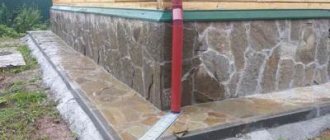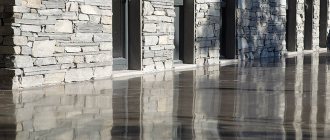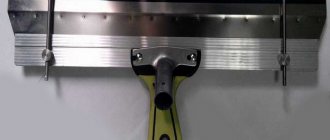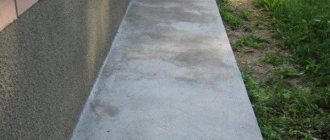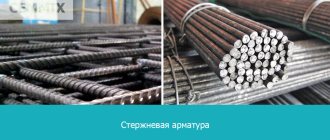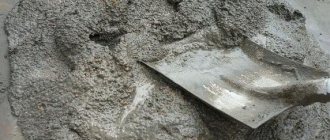Concrete is a very durable material. It copes well with adverse weather conditions and high loads. But concrete is not able to resist such a destruction process as surface abrasion, which results in the formation of cement dust on the floor surface. To combat this phenomenon, special impregnating compounds are used.
The need to use impregnations for concrete
Concrete is a porous material. Its strength depends largely on the hydration process of cement. As a result of this process, the pores of concrete may contain the gel substance of the cement mortar, moisture and air. All this negatively affects concrete during operation.
The presence of micropores causes two main disadvantages of this material:
- low hydrophobicity. Moisture seeps through the pores;
- insufficient concrete density, which reduces the strength of the finished floor.
Modern technologies make it possible to transform the porous structure of concrete and turn it into waterproof stone, which is especially important when creating concrete surfaces in contact with moisture.
The following problems are solved with the help of concrete impregnations:
- protection of concrete surfaces from chemicals and negative environmental factors;
- increasing the strength of concrete;
- increasing the wear resistance of concrete surfaces;
- dust removal of concrete structures;
- strengthening aged concrete structures;
- increasing the service life of concrete surfaces;
- improving the appearance of concrete floors.
Method 4 - installation of rubber coatings
Another option for making a floor in a garage if the concrete has begun to gather dust is to lay a ready-made rubber coating on it. Moreover, you can choose rolled materials, slabs of different shapes and sizes, or so-called rubber asphalt.
Rubber asphalt is a coating created from crumb rubber mixed with polyurethane glue or other polymer binder. Mixing is carried out immediately before laying, and to give the desired color, dyes are added to the still dry crumbs. The finished mixture is immediately applied to the prepared floor, primed with polyurethane glue, quickly leveled and rolled with a roller.
Classification of concrete impregnations
Impregnations for concrete, depending on the composition, are divided into two types:
- organic (polymer);
- inorganic (silicate).
Organic impregnations operate according to the following principle: the binding element of these liquid compositions fills the pores of concrete, giving the surface the ability to resist aggressive environments and repel water. In addition, impregnations of this type prevent concrete from dusting and make it more durable.
Inorganic impregnations have a different operating principle. They do not fill the micropores of concrete, but react with external molecular compounds, which eventually dissolve and become inert to other reactions. As a result, the concrete surface stops generating dust and acquires additional qualities such as strength and water resistance.
The most common today are organic impregnations, which in turn are divided into:
- acrylic;
- polyurethane;
- epoxy.
Acrylic compounds
Acrylic-based impregnations have a low price, but at the same time demonstrate good quality. They protect concrete very well from the effects of chlorides and moisture. In addition, they are highly resistant to ultraviolet radiation, maintaining their color throughout use.
Acrylic impregnations are used to remove dust from concrete floors that experience very light loads. For all their positive qualities, these compounds are not durable, so they need to be updated periodically (approximately every 2-3 years).
Polyurethane impregnations
Polyurethane impregnations are more effective than acrylic ones. They provide the concrete surface with both dust removal, resistance to chemical reagents, moisture resistance, and high strength. Polyurethane impregnations can be used to coat concrete, M350 cement screeds, concrete and metlakh tiles, and brick. They penetrate the concrete layer to a depth of 6 mm and can be used both indoors and outdoors, but under canopies. In addition, the use of impregnations of this type requires the presence of a waterproofing layer under the concrete base, which limits the access of capillary moisture into the concrete structure.
After applying polyurethane impregnation, concrete receives a number of additional properties:
- the strength of concrete increases to M600, regardless of its original grade;
- wear resistance increases by 8-10 times;
- Impact resistance is doubled;
- the water resistance of concrete and resistance to aggressive chemicals improves;
- Concrete dusting is completely eliminated;
- simplifies floor maintenance;
- the appearance of the concrete surface improves.
The popularity of polyurethane impregnations is facilitated by their properties, such as quick and easy application of the composition, and the low cost of the equipment used for this process. You can move on the treated surface on foot in just a day, and by transport in three days.
Epoxy impregnations
Epoxy-based impregnations can be either colorless or colored. They are more often used indoors, since under the influence of ultraviolet radiation they acquire a yellowish color. Epoxy impregnations are a two-component mixture, the obligatory components of which are a hardener and epoxy resin. Phenols, tertiary amines or their analogues are used as hardeners. The proportions of hardener and resin can be very different and depend on the area of application of the impregnation.
Compared to other impregnations, epoxy compounds have the following advantages:
- high strength;
- high resistance to abrasive effects;
- minimal moisture permeability;
- slight degree of shrinkage;
- The use of epoxy impregnations allows you to create concrete floors with a shiny surface or with an attractive “wet concrete” appearance.
When applied, epoxy impregnations do not emit such a strong odor as polyurethane impregnations, but in comparison with them they are less resistant to chemical and mechanical stress. Epoxy impregnations can be used in facilities such as medical institutions, food industry workshops, swimming pools, basement walls in buildings built in areas with high groundwater levels.
Methods for removing dust from a concrete floor, how to get rid of it yourself
To prevent the appearance of cement abrasive at the screed formation stage, they resort to the topping method. Here additives are added to the solution to strengthen the monolith. On the finished floor, dust removal from concrete is carried out by hardening the surface layer. For this purpose, special deep penetration compounds are used. The second method for doing it yourself is easier than the first. This can be explained by the peculiarities of technology and the relatively high prices of installation companies.
Types of materials and coatings for floor dust removal
Dust removal of floors that have not been hardened in advance is carried out using organic primers based on acrylic, polyurethane or epoxy resin. Among inorganic compositions, impregnations containing sodium silicate or lithium polysilicate are used for the same purpose. For topping, a composite based on a cement binder with mineral additives and plasticizers is prepared.
Strengthening products contain coloring ingredients. They do not affect the quality of materials. Their purpose is to simplify control over the formation of a continuous coating.
Functional properties of impregnations
Depending on the functionality, concrete impregnations are divided into:
- strengthening;
- water-repellent;
- dust removal;
- coloring.
Strengthening impregnations
Impregnations of this type are in most cases made on the basis of inorganic compounds - silicate primer compositions. They do not form a protective layer on the surface of concrete, since they penetrate deep into the material and change its structure. Thanks to this property, the impregnation does not peel off and provides the concrete surface with high wear resistance and complete dust removal.
Previously, deep penetration impregnations were made on the basis of sodium and potassium silicates. Now they have been replaced by new compositions based on lithium silicates. When using lithium impregnations, the possibility of efflorescence on concrete is eliminated. Concrete floors treated with such impregnations become highly resistant to mechanical abrasion and moisture, and also stop generating dust. Deep impregnation increases the strength of the surface layer of concrete by 2-3 times.
Water-repellent impregnations
Water-repellent (water-repellent) impregnations penetrate into the pores and cracks of concrete, protecting it from moisture penetration and the effects of such negative factors as:
- microorganisms, mold, fungi;
- salt/acid precipitation;
- UV rays;
- formation of efflorescence.
Water-repellent impregnations increase the frost resistance of concrete structures used outdoors. They also protect indoor structures from moisture, but do not protect the foundation from the penetration of groundwater. This problem is solved using a whole range of measures to waterproof a concrete structure.
Impregnations of this type are presented on the construction market in a very wide range. The most effective and expensive are two-component compositions used for treating hydraulic structures, such as swimming pools. This type of impregnation can essentially be called universal, but if concrete does not need such a set of qualities, then it is better to purchase specialized impregnation compositions, which are cheaper and do an excellent job with the assigned tasks.
Dust-removing impregnations
Impregnations of this type are widely used for exposed concrete floors that undergo heavy loads, as well as for protecting outdoor areas. Such a wide scope of application is due to the properties of impregnations, which, in addition to dust removal, also provide high wear resistance and strength of concrete surfaces.
Anti-dust compounds are used for the following purposes:
- preventing dust formation;
- increasing wear resistance and extending the service life of concrete surfaces;
- protecting the concrete floor from destruction, exposure to acids, alkalis and oils;
- making it easier to maintain concrete floors.
Coloring compounds
Concrete can be painted with regular paint or with a special colored impregnation. Painted surfaces are less durable. With constant traffic/traffic loads, the paint layer cracks and peels off.
Colored impregnations penetrate deep into concrete up to 3 millimeters, due to which the color of the floor is preserved for a long time, regardless of the intensity of exposure to various loads. But the concrete surface treated with a coloring composition must be additionally coated with a protective water-repellent impregnation.
Video description
This video shows how to properly paint concrete floors with polyurethane paint:
Urethane-alkyd
Used only for those concrete floors that are subject to minor loads, both mechanical and chemical. Therefore, if you are faced with the problem of how to paint the concrete floor in the garage so as not to create dust, then this paint is not for your situation. Because the garage floor is subjected to quite serious loads of both types.
A composition of this type must be applied to the concrete base in two layers. In this case, the first of them should be diluted with white spirit, and after application, dry thoroughly. Drying may take 3-4 hours or more, it all depends on the air temperature. The second layer will also dry, but it is recommended to use it only a day after application.
Attention! If the concrete screed was constructed recently, then it can be painted with urethane-alkyd paint only after a month.
And a few more recommendations. This type of paint is flammable. They cause an allergic reaction in people. That is, when working with them, you need to wear respirators and protective gloves, and also ensure that the room is well ventilated.
Urethane-alkyd based concrete paint Source beton-house.com
Review of impregnations from different manufacturers
Currently, manufacturers offer a huge range of concrete impregnations of various types. This section presents those that have gained a good reputation among builders and are very popular.
Strengthening primer for concrete floors Protector.
This composition strengthens the concrete surface, removes dust and improves the resistance of concrete to chemical reagents.
Impregnation Protector is used in the construction of concrete surfaces for a wide variety of purposes: floors, roads, pedestrian paths, runways. The composition is produced in containers of 20 liters. The cost of 1 liter is 180 rubles.
Strengthening impregnation Retroplate
It is used for dust removal and strengthening of low-quality concrete (less than M300), as well as old and new mosaic floors.
When working with this impregnation, the following nuances must be taken into account:
- impregnation cannot be used on uncured concrete (at least 14 days must pass after pouring);
- The composition is applied at an air temperature of at least +5 degrees.
The composition is produced in 20 liter buckets. The price of one liter is approximately 400 rubles.
Organic impregnation Protexil
Designed specifically for treating floors in industrial facilities. It perfectly protects the concrete floor from aggressive environments, high mechanical and transport loads.
Technical and operational characteristics of Protexil:
- penetration depth – 5-10 mm;
- material consumption – 0.3 liters per square meter;
- operating temperature range – from -40 to +80 degrees;
- drying time is up to six hours at a temperature of +20 degrees;
- the cost of impregnation is 170-190 rubles per liter.
Universal impregnation Monolit 20-M
This is a water-based composition, so it is environmentally friendly and non-flammable.
Impregnation acts on a concrete floor as follows:
- increases the water resistance of concrete by three grades;
- increases wear resistance and hardness by 30%;
- reduces concrete warping and the formation of shrinkage cracks;
- removes dust from concrete;
- improves concrete adhesion;
- increases resistance to organic acids and petroleum products.
The impregnation consumption of Monolith 20-M is one liter per 3-5 square meters (depending on the porosity and condition of the concrete). The price of one liter is 130 rubles.
Impregnation Aquastone
This impregnation provides dust removal and surface protection for concrete, mosaic floors and cement-sand screeds. It exhibits excellent penetration, providing high strength and hardness to the concrete surface. Recommended for use on both industrial and domestic floors. It can be applied to substrates with high humidity. The price of one liter is 220 rubles.
Impregnation Aquasol
Impregnation is a water-repellent composition and is used to protect any cement-based building materials from moisture and other harmful atmospheric influences. One liter of this impregnation costs 210 rubles.
Impregnation Epoxol
It is an epoxy water-dispersed composition and is used for strengthening, dust removal and protection of concrete and magnesium floors, cement screeds. It increases the compressive strength of concrete by 2-3 times and prevents the formation of cracks. Epoxol can be applied to wet concrete. Recommended for strengthening floors in warehouses, pharmaceutical and food industries, public and residential premises, medical and children's institutions. The price of one liter is 380 rubles.
Impregnation Ashford Formula
The impregnation is a water-based silicate polymer. Recommended for strengthening concrete surfaces of indoor and outdoor areas of logistics terminals, warehouses, production workshops, markets, shopping centers, garages, parking lots, runways and other facilities with increased transport and pedestrian load. The cost of one liter is approximately 110 rubles.
Main brands and manufacturers of primer for concrete
When choosing, you should not be guided only by price. It is best to purchase materials from well-known manufacturers, but even in this case it is possible to stumble upon a fake. If you are going to purchase paintwork materials from a regional manufacturer, you should look for reviews or ask for advice from professional finishers. The most well-known manufacturers, as a rule, produce other paints and varnishes with a compatible composition.
- Knauf. The brand's most popular product: Betokontact adhesive primer, designed for treating absorbent substrates in interior spaces;
It is impossible to save money on repairs by crossing primer off your shopping list. The cost of a primer composition can be quite high, for example, options for heated floors or decorative plaster. But ensuring reliability in any other way is difficult.
Tips for choosing impregnation
When choosing an impregnation for concrete, the following must be considered:
- Silicate (inorganic) compounds are used when:
- it is necessary to remove dust from the concrete floor at minimal cost;
- the concrete surface has significant unevenness and roughness;
- the floor will be subject to harsh use (dragging heavy objects, high temperature exposure).
- Polymer (organic) impregnations are best used in the following cases:
- intensive exposure to chemicals on concrete pavement;
- high requirements for the aesthetic appearance of a concrete floor;
- dust removal of mosaic floors.
When using impregnating compositions, the following requirements must be taken into account:
- no impregnation is applied to a fresh concrete floor, even if it is already possible to walk on it. At least two weeks must pass for the concrete to mature and gain the strength necessary for the application of impregnations;
- The concrete surface must be well dried. The presence of water in the pores of concrete is unacceptable. The floor must also be thoroughly cleaned of dust and dirt;
- It is best to apply impregnation at an air temperature of +20 - +25 degrees and humidity - no more than 90%;
- the temperature of the concrete floor should be at least +10 degrees, although some impregnations can be used at lower temperatures;
- Before applying water-repellent compounds, it is advisable to rub the concrete floor with fine quartz sand to give it anti-slip properties;
- all visible defects of the concrete coating must be removed - cracks and chips must be sanded;
- for work you should use brushes and rollers that are resistant to solvents;
- When working, it is necessary to observe safety precautions, using personal protective equipment (respirators, clothing made of cotton fabrics, shoes with rubber soles, gloves).
Which concrete primer is best to choose for interior and exterior work?
There are options designed for external, internal and universal work. The manufacturer may indicate on the container: for wood, metal and mineral surfaces.
Under no circumstances should concrete primer for exterior use be used in interior spaces; it contains toxic solvents that can be harmful to health. In addition, all its advantages in protecting facade walls or parking lot coverings will never be useful in an apartment. If you use a primer for interior decoration outdoors, it will quickly lose its properties.
Compositions should be purchased strictly in accordance with their purpose. In addition, an expired solution may not have the required adhesion or antiseptic characteristics.
Homemade recipe
You can also make a product for treating a concrete floor for dust removal with your own hands. The performance of floors coated with such substances is often not very high, but in certain cases and rooms without serious loads, this option may be acceptable.
Recipes for preparing compositions for concrete dust removal:
- PVA glue (it is better to take PVA-m or PVA-k) with water in a ratio of 1:8 - mix until a homogeneous solution is obtained, apply to concrete.
- Dilute latex with water (the proportion is chosen according to the type of substance).
- Dissolve pieces of polystyrene foam in acetone or gasoline, add a little xylene. Apply the mixture to concrete - within a few hours the gasoline will evaporate and the polymer will protect the floor from water.
Option number 4. Rubber floor
Another option that meets all your garage flooring needs is rubber flooring. The material is based on crumb rubber, which is mixed with adhesives, various modifiers and dyes. This mixture is used to produce rolls, tiles, mats, and liquid rubber.
Advantages:
- good resistance to shock loads, so the material does not care about the fall of heavy objects, and it can easily withstand the weight of the car;
- resistance to aggressive substances, moisture, temperature changes;
- good thermal and sound insulation performance;
- non-slip surface;
- high elasticity, therefore it is comfortable to walk on the rubber floor;
- durability;
- ease of care.
The material is not recommended for use near open fire sources - this limitation is the main disadvantage of the coating.
Rubber flooring in the form of rolls is best suited for the garage. The thickness ranges from 2 to 12 mm; there is cord reinforcement, which gives the material additional strength. You can find rolls of different shades on sale; the coating is relatively easy to install, but over time it can peel off in the corners. Modular tiles also performed well, from which you can lay out a pattern on the floor. Installing such a covering is relatively simple, and in case of damage, individual tiles can be easily replaced - you just need to take extra material in advance. Another option is to create a seamless coating by spraying liquid rubber. The main disadvantage of this option is the fear of shock loads.
Summary: what kind of primer is needed?
The choice of one type of soil or another should be based on two factors - the type of base and the type of decorative finishing carried out. Our recommendations are as follows:
- Deep penetration soils will be effective only on walls with a “crumble” and “chalking” effect. Their task is to strengthen the surface layer of the material and bind its structure. This allows you to increase the reliability of the base itself and increase adhesion to solutions.
- Universal primers are suitable for finishing work, where it is important to reduce the moisture absorption of surfaces. For example, for processing foam, aerated concrete, silicate blocks, when installing ceramic tiles or wallpapering. The primed surface promotes hydration of the plaster, giving more time for leveling the tiles or joining the panels.
- Betonokontakt soils are best used when installing cement and gypsum plasters and only on weakly absorbent substrates . Otherwise, you will not achieve a significant effect, and sometimes you can even worsen the situation.
Soils are not a panacea that necessarily guarantees excellent results. Primers are, first of all, auxiliary means that simplify the installation process and make it better and more reliable. The main thing, in this case, is to choose the right and suitable composition and strictly follow the installation technology of a particular solution, glue, or paint.
